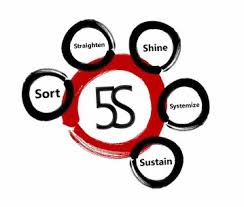Why bother with the good housekeeping? For many reasons …
You’d want a safe place for your employees to work in, a place they would be happy and proud to belong to and call their second home. You’d want things organized to facilitate work processes and operations and boost productivity. You’d want the work to proceed more quickly and develop control through visibility.
The 5 S Good Housekeeping Practice, which originated from Japan, is now firmly entrenched in many workplaces around the world, big and small. It is assumed to provide the groundwork for workplace improvement.
According to the Asian Productivity Organization, the cornerstone of 5S is that untidy, cluttered work areas are not productive. Junk gets in everybody’s way and dirt compromises quality. We are all happier in a clean and tidy environment and hence more inclined to work hard with due care and attention. Thus, 5S and good housekeeping are core elements of “lean thinking” and a “visual workplace” are a fundamental platform for world-class manufacturing.
A place for everything and everything in its place — a very basic rule all of us learned since childhood.
This is more or less what 5 S is about. To have only what you need available in the workplace, a designated place for everything, a standard way of doing things, and the discipline to maintain and make it a part of the work culture.
5S was derived from the Japanese words seiri, seiton, seiso, seiketsu, and shitsuke. In English, they can be roughly translated as sort, set in order, shine, standardize, and sustain.
|
SORT The first stage of 5S is to organize the work area, leaving only the tools and materials necessary to perform daily activities. When “sorting” is well implemented, communication between workers is improved and product quality and productivity are increased. |
|
|
|
SET IN ORDER The second stage of 5S involves the orderly arrangement of needed items so they are easy to use and accessible for “anyone” to find. Orderliness eliminates waste in production and clerical activities. |
|
|
|
SHINE The third stage of 5S is keeping everything clean and swept. This maintains a safer work area and problem areas are quickly identified. An important part of “shining” is “Mess Prevention.” In other words, don’t allow litter, scrap, shavings, cuttings, etc., to land on the floor in the first place.
|
|
|
|
STANDARDIZE The fourth stage of 5S involves creating a consistent approach for carrying out tasks and procedures. Orderliness is the core of “standardization” and is maintained by Visual Controls. Some of these visual control tools are:
|
|
|
|
SUSTAIN This last stage of 5S is the discipline and commitment of all other stages. Without “sustaining”, your workplace can easily revert back to being dirty and chaotic. That is why it is so crucial for your team to be empowered to improve and maintain their workplace. When employees take pride in their work and workplace it can lead to greater job satisfaction and higher productivity. |
(Watch out for more articles on how to set up 5 S .)

